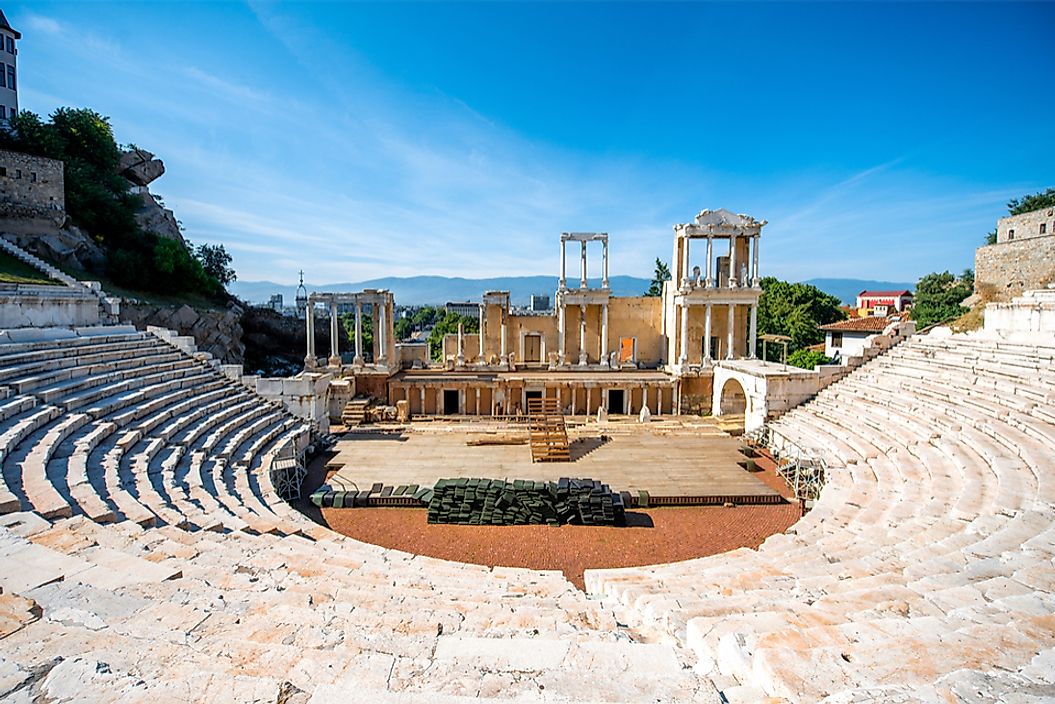What Is the Oldest Continuously Inhabited City in Europe?

Many cities claim to be the oldest continuously inhabited area within a particular region. This is true on every continent in the world, but only one has sufficient evidence to support this claim in Europe: the city of Plovdiv, Bulgaria. The history of Plovdiv stretches back over 8,000 years. Throughout this time, the city has attracted and kept human inhabitants.
The city of Plovdiv is located in the south central area of Bulgaria. It covers an area of about 39.37 square miles and has a metropolitan population of 675,586, making it the second most populated city in the country. This city is situated along both sides of the Maritsa river and is characterized by six hills formed of syenite, an igneous rock that is similar in appearance to granite. Previously, the city sat within seven of these hills, but one was destroyed. Given its historical geographic appearance, Plovdiv is sometimes referred to as the City of the Seven Hills.
History of Plovdiv, Bulgaria
Archaeological evidence indicates that the location of Plovdiv has been inhabited since the Neolithic Age. Between 5000 and 6000 BC, the area became a permanent human settlement, and by the 5th millennium BC it became part of the Odrysian kingdom, which was ruled by the Thracian culture. Plovdiv was briefly controlled by Philip II of Macedon, who renamed the settlement Philippopolis. In 46 BC, the Roman Empire gained control of the area, which marked a period of growth and development.
By the end of the 7th century AD, the Byzantine Empire claimed the city for approximately 550 years, with the exception of the period between 812 and 970 AD, when it was part of the Bulgarian Empire. Control of Plovdiv once again switched hands in 1204 AD and the city was incorporated into the Latin Empire. Under this empire, it was designated as the capital of the Duchy of Philippopolis. During the 13th and 14th centuries, the city experienced significant political instability and was conquered by a number of ruling parties, but this ended for when the Ottoman Turks took control of the area in 1371 and made it part of the Ottoman Empire.
During its ancient history and through the Ottoman Empire, Plovdiv was given several names including: Pulden, Eumolpinae, Filibe, Kendros, Philippopolis, Populdin, Thrimonzium, and Ploudin. The first use of Plovdiv was recorded in the 14th century AD.
Independence of Plovdiv
Plovdiv remained under Ottoman rule for approximately 500 years and earned its independence after the Battle of Philippopolis in 1878. After its independence, Plovdiv became the capital of Eastern Rumelia, an autonomous region created by the Congress of Berlin which separated the newly formed Principality of Bulgaria. The country was again united in 1885, at which time Sofia became the new national capital.
As the second largest city in a newly independent country, Plovdiv once again began to grow economically and became an important trading, manufacturing, and banking center. At the beginning of the 20th century, the primary products produced in Plovdiv were food and tobacco. After World War II, more factories were established, and over time the city grew in size.
Plovdiv Today
Today, Plovdiv is home to an international airport, a number of tourism agencies, and a large commercial sector. Additionally, it has developed a significant outsourcing and technology services sector. The city's economy contributes approximately 7.5% to the national gross domestic product (GDP). Formal employment in this city is categorized according to the following industries: manufacturing (36%), commerce (16%), education (8%), healthcare (7%), transport (6%), and a combination of other sectors (27%).
Demographics of Plovdiv
The metropolitan population of Plovdiv is about 675,586. Of this total, approximately 339,077 individuals live within the city limits. The vast majority of this population (nearly 90%) identifies as Bulgarian, which is considered a South Slavic ethnicity that is native to the region. This group is believed to have descended from the Thracian indigenous group, the Bulgars, and the early Slavic Turks make up approximately 5.2% of the population. The third largest ethnic group in Plovdiv is made up of Roma (3.1%). This percentage represents a significant increase from 2001, when the Roma people made up only 1.5% of the population. Other ethnicities found in Plovdiv include Armenians, Jews, Greeks, and other smaller minority groups. The most widely practiced religion in this city is Easter Orthodox Christianity. Other religious groups include Catholics, Muslims, Protestants, and Jews.
Tourism in Plovdiv
Because of its history and culture, Plovdiv is a popular destination for tourists from around the world. The city offers beautiful scenery, ancient ruins, interesting architecture, and modern amenities. Tourists enjoy visiting Plovdiv because it provides a glimpse of life throughout history, beginning with its theater ruins from the ancient era and continuing through to its cobblestone streets from the National Revival period.
One of the most popular tourist attractions is known as the Roman City, one of the two ancient theaters located here. Built at the end of the 1st century AD, this theater is located between two of the famous hills and has a seating capacity of 7,000 individuals. The municipal government and population of Plovdiv are so committed to preserving the long history and culture of this place that the Roman City theater was restored during the late 20th century. Today, it is used for a number of modern festivals, including the International Folklore festival, the Sounds of the Ages rock music festival, and the Open Opera festival.
Tourists also visit the Old Town area, which is home to a unique local architectural style. This style, known as Bulgarian Renaissance, features numerous, long rectangular windows with wooden frames and jewel-toned exteriors. This area of town is also home to a number of museums, like the Regional Ethnographic Museum, which houses over 40,000 exhibits. Other popular tourist attractions in Plovdiv include Eastern Orthodox churches, the Sephardic Plovdiv Synagogue, and the Djumaya Mosque.











